Key Features of Common Law or Civil Law Systems -
VerifiedAdded on 2022/08/22
|9
|1763
|26
AI Summary
Contribute Materials
Your contribution can guide someone’s learning journey. Share your
documents today.
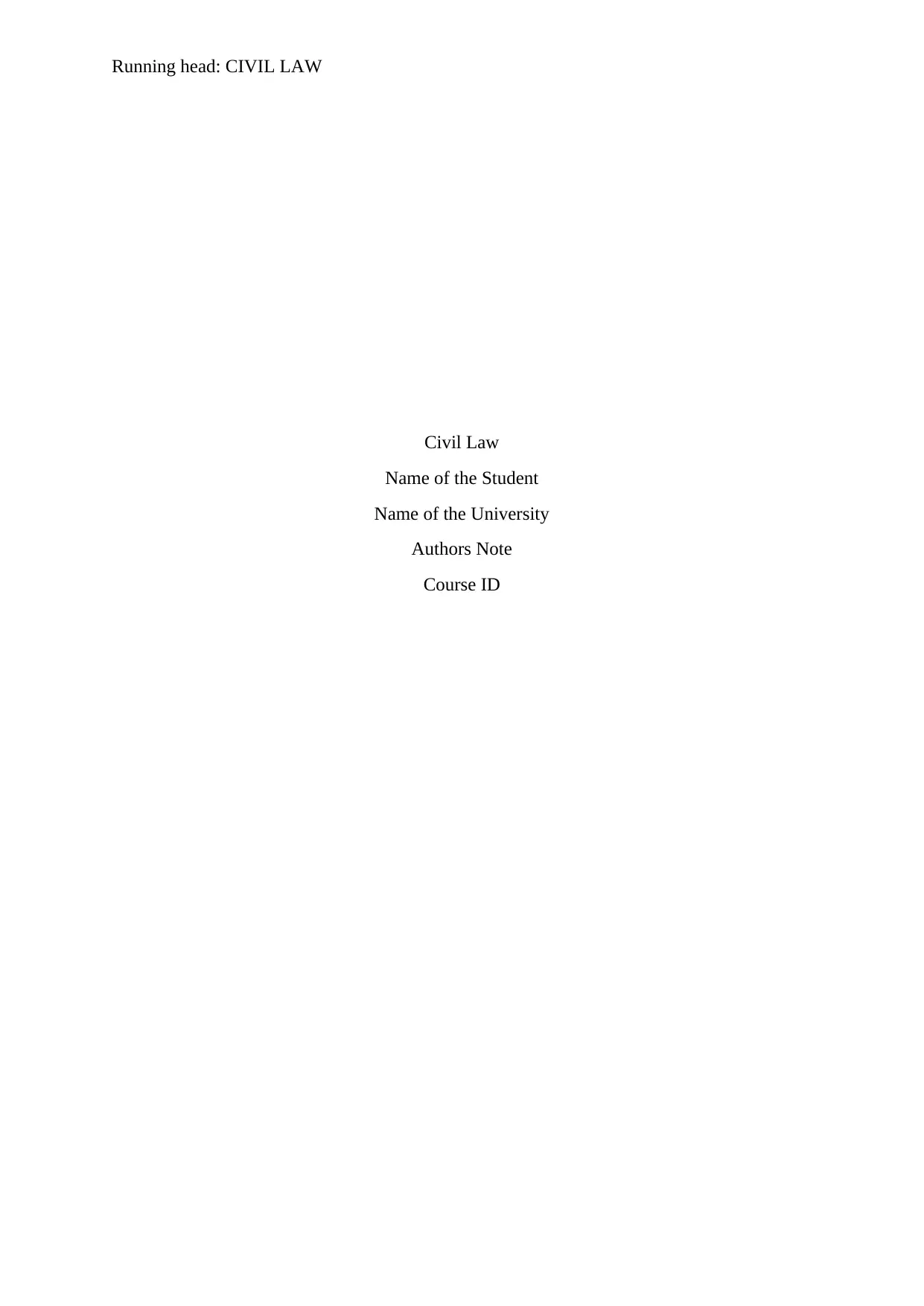
Running head: CIVIL LAW
Civil Law
Name of the Student
Name of the University
Authors Note
Course ID
Civil Law
Name of the Student
Name of the University
Authors Note
Course ID
Secure Best Marks with AI Grader
Need help grading? Try our AI Grader for instant feedback on your assignments.
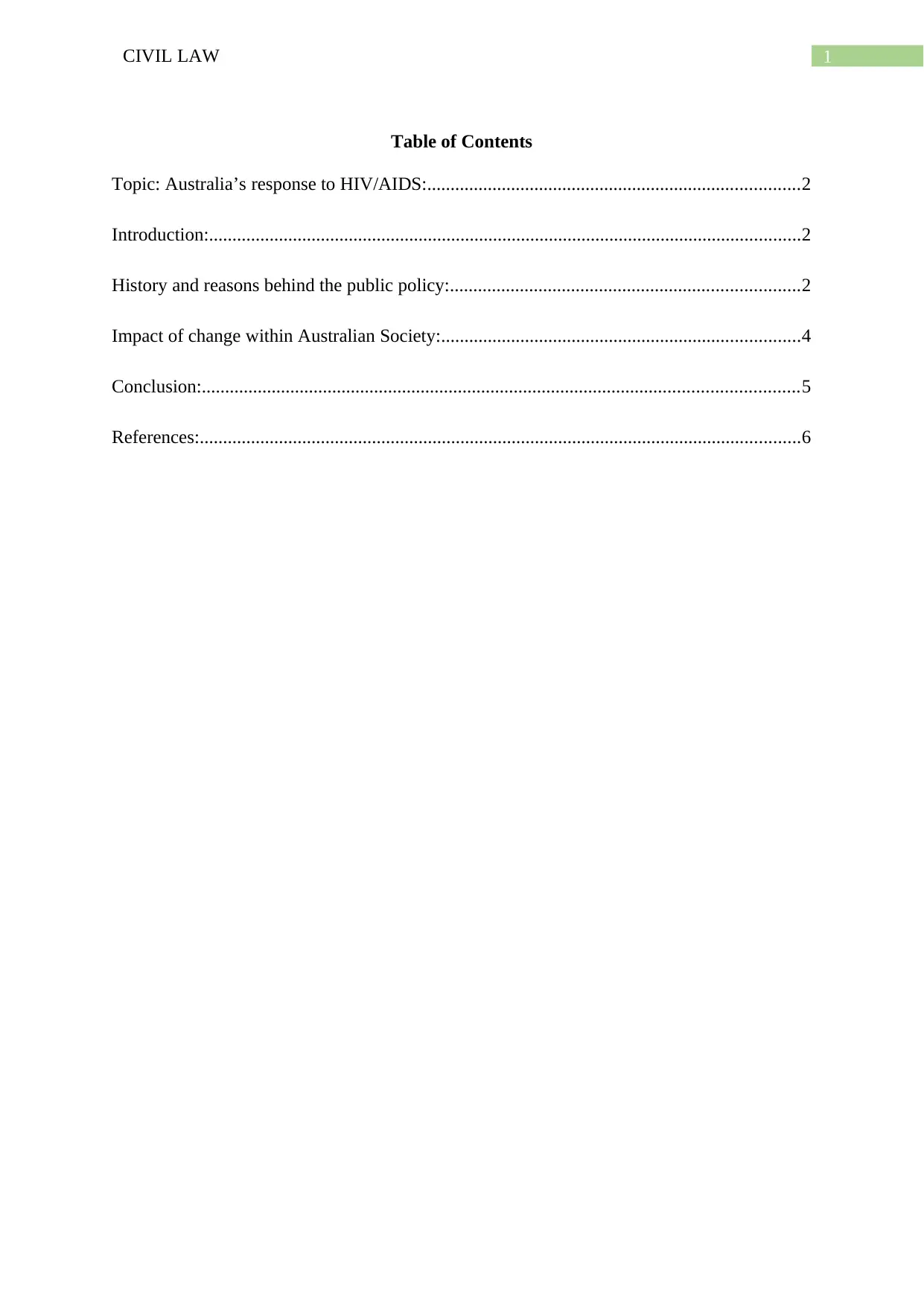
1CIVIL LAW
Table of Contents
Topic: Australia’s response to HIV/AIDS:................................................................................2
Introduction:...............................................................................................................................2
History and reasons behind the public policy:...........................................................................2
Impact of change within Australian Society:.............................................................................4
Conclusion:................................................................................................................................5
References:.................................................................................................................................6
Table of Contents
Topic: Australia’s response to HIV/AIDS:................................................................................2
Introduction:...............................................................................................................................2
History and reasons behind the public policy:...........................................................................2
Impact of change within Australian Society:.............................................................................4
Conclusion:................................................................................................................................5
References:.................................................................................................................................6
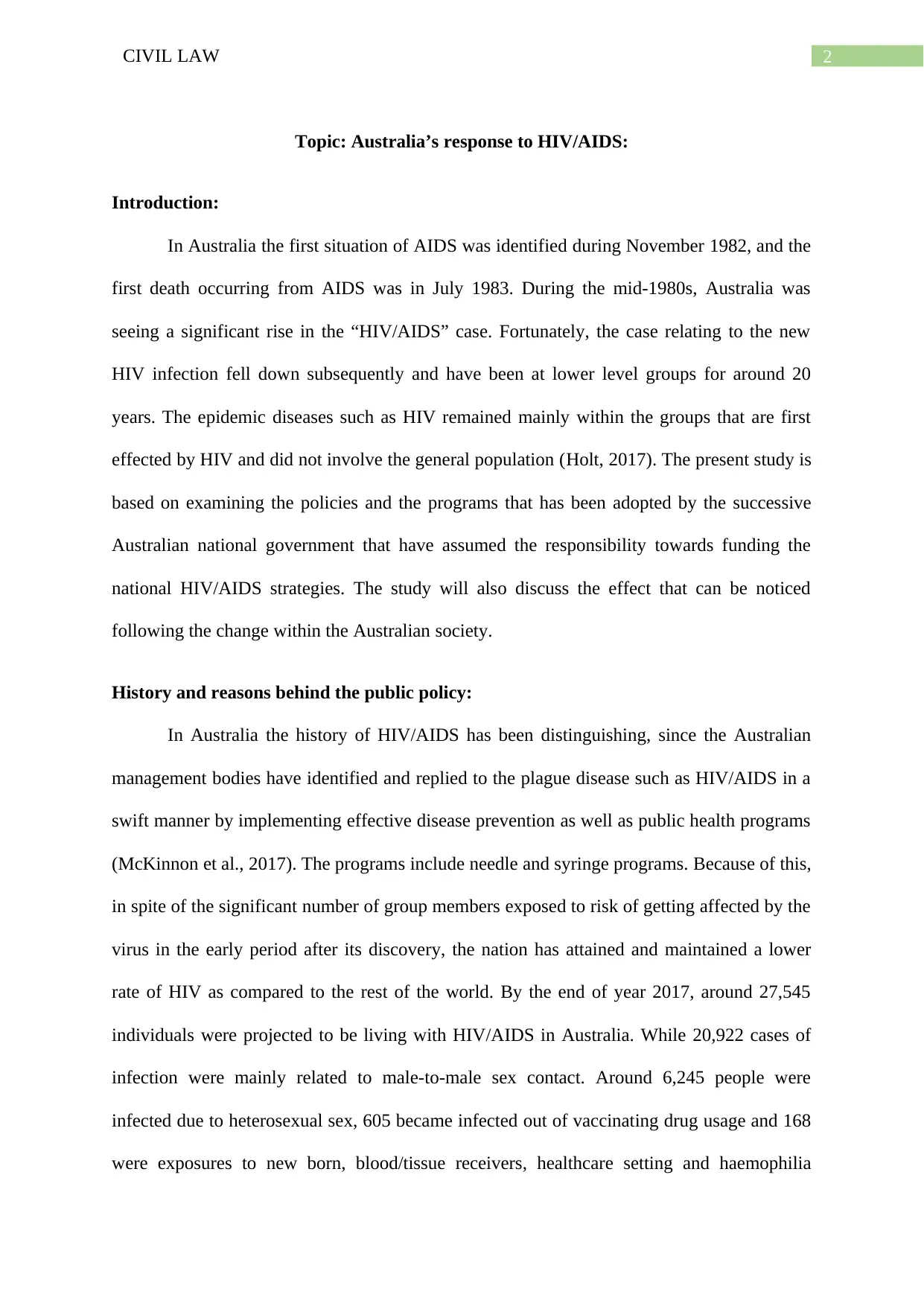
2CIVIL LAW
Topic: Australia’s response to HIV/AIDS:
Introduction:
In Australia the first situation of AIDS was identified during November 1982, and the
first death occurring from AIDS was in July 1983. During the mid-1980s, Australia was
seeing a significant rise in the “HIV/AIDS” case. Fortunately, the case relating to the new
HIV infection fell down subsequently and have been at lower level groups for around 20
years. The epidemic diseases such as HIV remained mainly within the groups that are first
effected by HIV and did not involve the general population (Holt, 2017). The present study is
based on examining the policies and the programs that has been adopted by the successive
Australian national government that have assumed the responsibility towards funding the
national HIV/AIDS strategies. The study will also discuss the effect that can be noticed
following the change within the Australian society.
History and reasons behind the public policy:
In Australia the history of HIV/AIDS has been distinguishing, since the Australian
management bodies have identified and replied to the plague disease such as HIV/AIDS in a
swift manner by implementing effective disease prevention as well as public health programs
(McKinnon et al., 2017). The programs include needle and syringe programs. Because of this,
in spite of the significant number of group members exposed to risk of getting affected by the
virus in the early period after its discovery, the nation has attained and maintained a lower
rate of HIV as compared to the rest of the world. By the end of year 2017, around 27,545
individuals were projected to be living with HIV/AIDS in Australia. While 20,922 cases of
infection were mainly related to male-to-male sex contact. Around 6,245 people were
infected due to heterosexual sex, 605 became infected out of vaccinating drug usage and 168
were exposures to new born, blood/tissue receivers, healthcare setting and haemophilia
Topic: Australia’s response to HIV/AIDS:
Introduction:
In Australia the first situation of AIDS was identified during November 1982, and the
first death occurring from AIDS was in July 1983. During the mid-1980s, Australia was
seeing a significant rise in the “HIV/AIDS” case. Fortunately, the case relating to the new
HIV infection fell down subsequently and have been at lower level groups for around 20
years. The epidemic diseases such as HIV remained mainly within the groups that are first
effected by HIV and did not involve the general population (Holt, 2017). The present study is
based on examining the policies and the programs that has been adopted by the successive
Australian national government that have assumed the responsibility towards funding the
national HIV/AIDS strategies. The study will also discuss the effect that can be noticed
following the change within the Australian society.
History and reasons behind the public policy:
In Australia the history of HIV/AIDS has been distinguishing, since the Australian
management bodies have identified and replied to the plague disease such as HIV/AIDS in a
swift manner by implementing effective disease prevention as well as public health programs
(McKinnon et al., 2017). The programs include needle and syringe programs. Because of this,
in spite of the significant number of group members exposed to risk of getting affected by the
virus in the early period after its discovery, the nation has attained and maintained a lower
rate of HIV as compared to the rest of the world. By the end of year 2017, around 27,545
individuals were projected to be living with HIV/AIDS in Australia. While 20,922 cases of
infection were mainly related to male-to-male sex contact. Around 6,245 people were
infected due to heterosexual sex, 605 became infected out of vaccinating drug usage and 168
were exposures to new born, blood/tissue receivers, healthcare setting and haemophilia
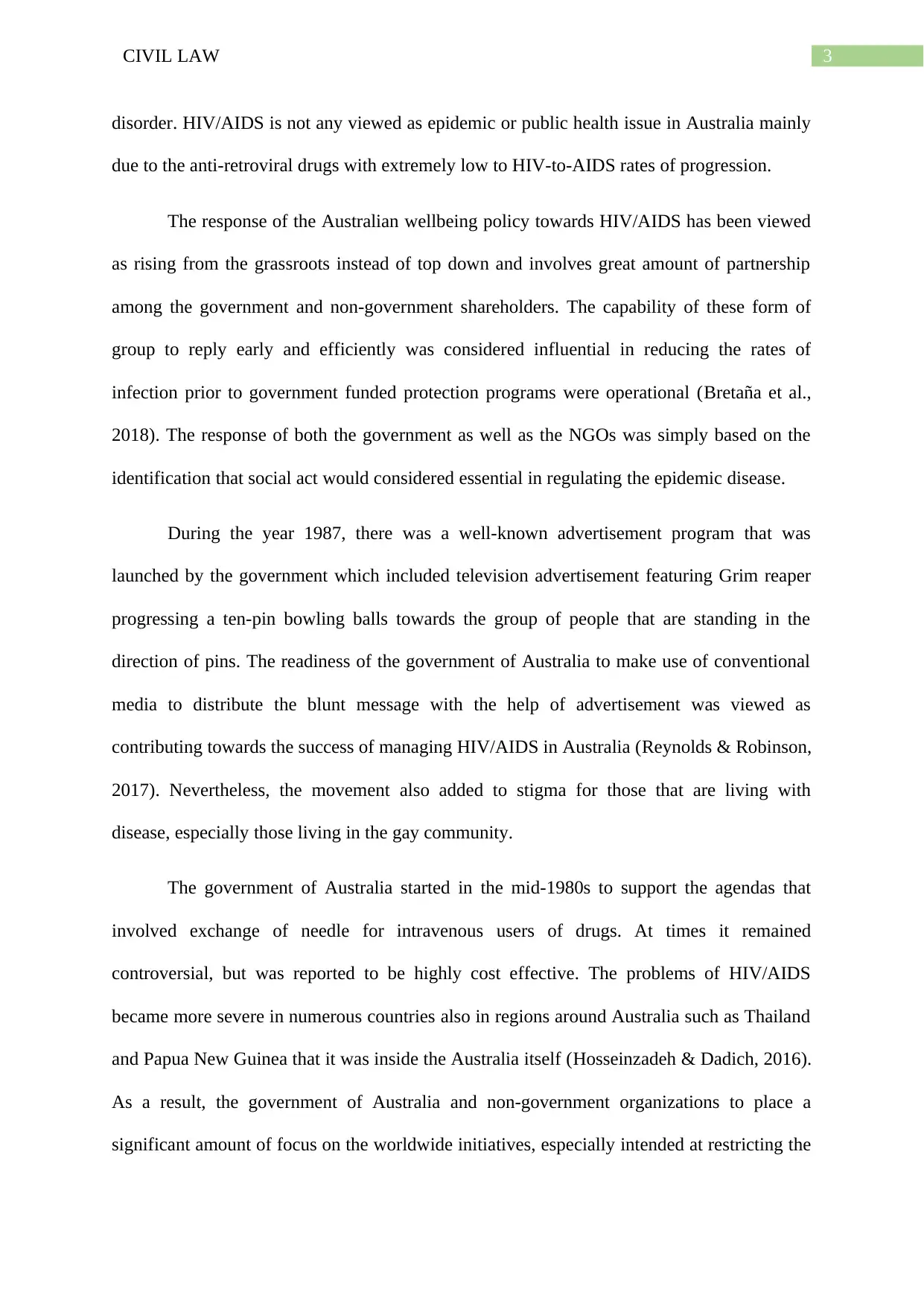
3CIVIL LAW
disorder. HIV/AIDS is not any viewed as epidemic or public health issue in Australia mainly
due to the anti-retroviral drugs with extremely low to HIV-to-AIDS rates of progression.
The response of the Australian wellbeing policy towards HIV/AIDS has been viewed
as rising from the grassroots instead of top down and involves great amount of partnership
among the government and non-government shareholders. The capability of these form of
group to reply early and efficiently was considered influential in reducing the rates of
infection prior to government funded protection programs were operational (Bretaña et al.,
2018). The response of both the government as well as the NGOs was simply based on the
identification that social act would considered essential in regulating the epidemic disease.
During the year 1987, there was a well-known advertisement program that was
launched by the government which included television advertisement featuring Grim reaper
progressing a ten-pin bowling balls towards the group of people that are standing in the
direction of pins. The readiness of the government of Australia to make use of conventional
media to distribute the blunt message with the help of advertisement was viewed as
contributing towards the success of managing HIV/AIDS in Australia (Reynolds & Robinson,
2017). Nevertheless, the movement also added to stigma for those that are living with
disease, especially those living in the gay community.
The government of Australia started in the mid-1980s to support the agendas that
involved exchange of needle for intravenous users of drugs. At times it remained
controversial, but was reported to be highly cost effective. The problems of HIV/AIDS
became more severe in numerous countries also in regions around Australia such as Thailand
and Papua New Guinea that it was inside the Australia itself (Hosseinzadeh & Dadich, 2016).
As a result, the government of Australia and non-government organizations to place a
significant amount of focus on the worldwide initiatives, especially intended at restricting the
disorder. HIV/AIDS is not any viewed as epidemic or public health issue in Australia mainly
due to the anti-retroviral drugs with extremely low to HIV-to-AIDS rates of progression.
The response of the Australian wellbeing policy towards HIV/AIDS has been viewed
as rising from the grassroots instead of top down and involves great amount of partnership
among the government and non-government shareholders. The capability of these form of
group to reply early and efficiently was considered influential in reducing the rates of
infection prior to government funded protection programs were operational (Bretaña et al.,
2018). The response of both the government as well as the NGOs was simply based on the
identification that social act would considered essential in regulating the epidemic disease.
During the year 1987, there was a well-known advertisement program that was
launched by the government which included television advertisement featuring Grim reaper
progressing a ten-pin bowling balls towards the group of people that are standing in the
direction of pins. The readiness of the government of Australia to make use of conventional
media to distribute the blunt message with the help of advertisement was viewed as
contributing towards the success of managing HIV/AIDS in Australia (Reynolds & Robinson,
2017). Nevertheless, the movement also added to stigma for those that are living with
disease, especially those living in the gay community.
The government of Australia started in the mid-1980s to support the agendas that
involved exchange of needle for intravenous users of drugs. At times it remained
controversial, but was reported to be highly cost effective. The problems of HIV/AIDS
became more severe in numerous countries also in regions around Australia such as Thailand
and Papua New Guinea that it was inside the Australia itself (Hosseinzadeh & Dadich, 2016).
As a result, the government of Australia and non-government organizations to place a
significant amount of focus on the worldwide initiatives, especially intended at restricting the
Secure Best Marks with AI Grader
Need help grading? Try our AI Grader for instant feedback on your assignments.
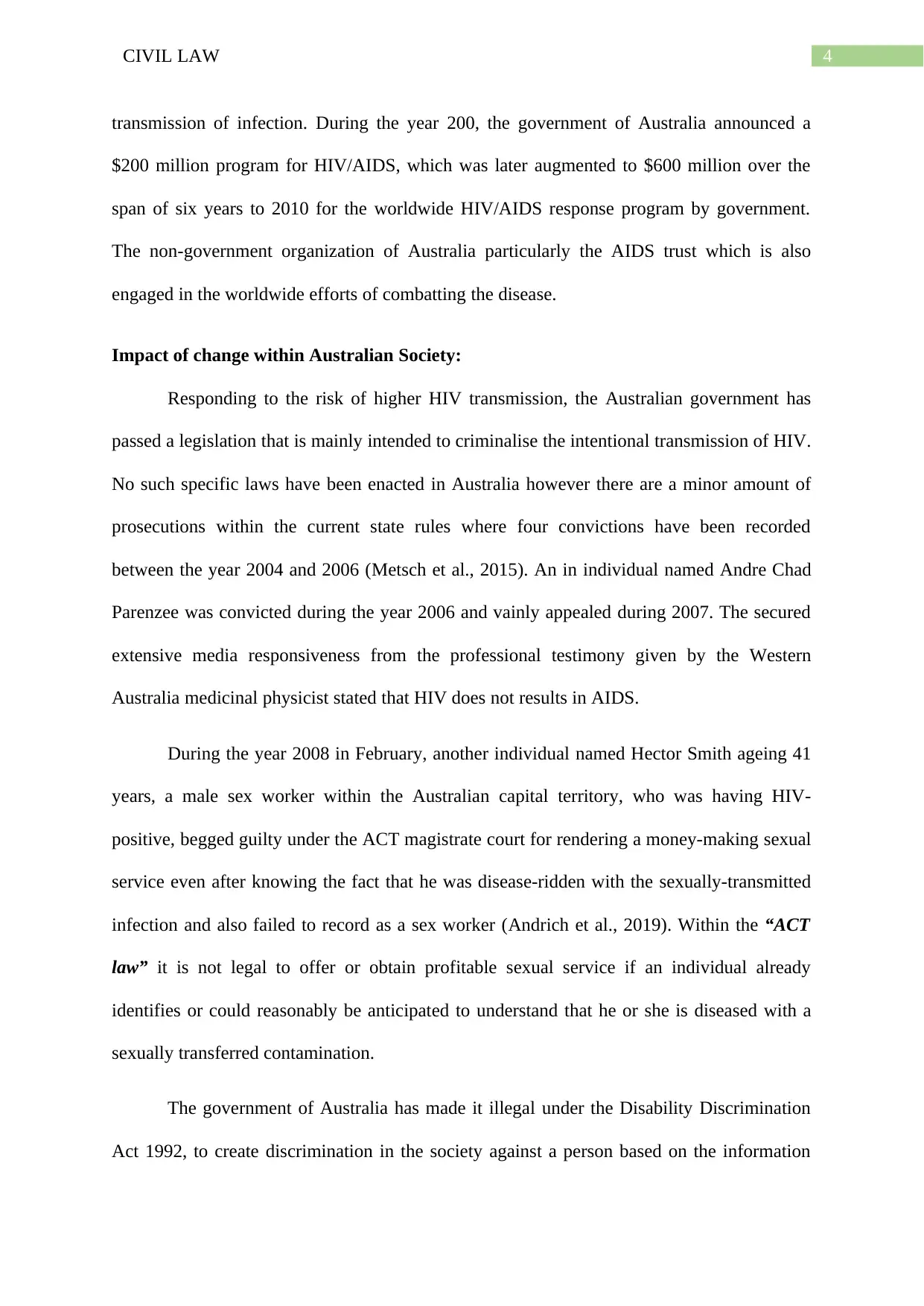
4CIVIL LAW
transmission of infection. During the year 200, the government of Australia announced a
$200 million program for HIV/AIDS, which was later augmented to $600 million over the
span of six years to 2010 for the worldwide HIV/AIDS response program by government.
The non-government organization of Australia particularly the AIDS trust which is also
engaged in the worldwide efforts of combatting the disease.
Impact of change within Australian Society:
Responding to the risk of higher HIV transmission, the Australian government has
passed a legislation that is mainly intended to criminalise the intentional transmission of HIV.
No such specific laws have been enacted in Australia however there are a minor amount of
prosecutions within the current state rules where four convictions have been recorded
between the year 2004 and 2006 (Metsch et al., 2015). An in individual named Andre Chad
Parenzee was convicted during the year 2006 and vainly appealed during 2007. The secured
extensive media responsiveness from the professional testimony given by the Western
Australia medicinal physicist stated that HIV does not results in AIDS.
During the year 2008 in February, another individual named Hector Smith ageing 41
years, a male sex worker within the Australian capital territory, who was having HIV-
positive, begged guilty under the ACT magistrate court for rendering a money-making sexual
service even after knowing the fact that he was disease-ridden with the sexually-transmitted
infection and also failed to record as a sex worker (Andrich et al., 2019). Within the “ACT
law” it is not legal to offer or obtain profitable sexual service if an individual already
identifies or could reasonably be anticipated to understand that he or she is diseased with a
sexually transferred contamination.
The government of Australia has made it illegal under the Disability Discrimination
Act 1992, to create discrimination in the society against a person based on the information
transmission of infection. During the year 200, the government of Australia announced a
$200 million program for HIV/AIDS, which was later augmented to $600 million over the
span of six years to 2010 for the worldwide HIV/AIDS response program by government.
The non-government organization of Australia particularly the AIDS trust which is also
engaged in the worldwide efforts of combatting the disease.
Impact of change within Australian Society:
Responding to the risk of higher HIV transmission, the Australian government has
passed a legislation that is mainly intended to criminalise the intentional transmission of HIV.
No such specific laws have been enacted in Australia however there are a minor amount of
prosecutions within the current state rules where four convictions have been recorded
between the year 2004 and 2006 (Metsch et al., 2015). An in individual named Andre Chad
Parenzee was convicted during the year 2006 and vainly appealed during 2007. The secured
extensive media responsiveness from the professional testimony given by the Western
Australia medicinal physicist stated that HIV does not results in AIDS.
During the year 2008 in February, another individual named Hector Smith ageing 41
years, a male sex worker within the Australian capital territory, who was having HIV-
positive, begged guilty under the ACT magistrate court for rendering a money-making sexual
service even after knowing the fact that he was disease-ridden with the sexually-transmitted
infection and also failed to record as a sex worker (Andrich et al., 2019). Within the “ACT
law” it is not legal to offer or obtain profitable sexual service if an individual already
identifies or could reasonably be anticipated to understand that he or she is diseased with a
sexually transferred contamination.
The government of Australia has made it illegal under the Disability Discrimination
Act 1992, to create discrimination in the society against a person based on the information
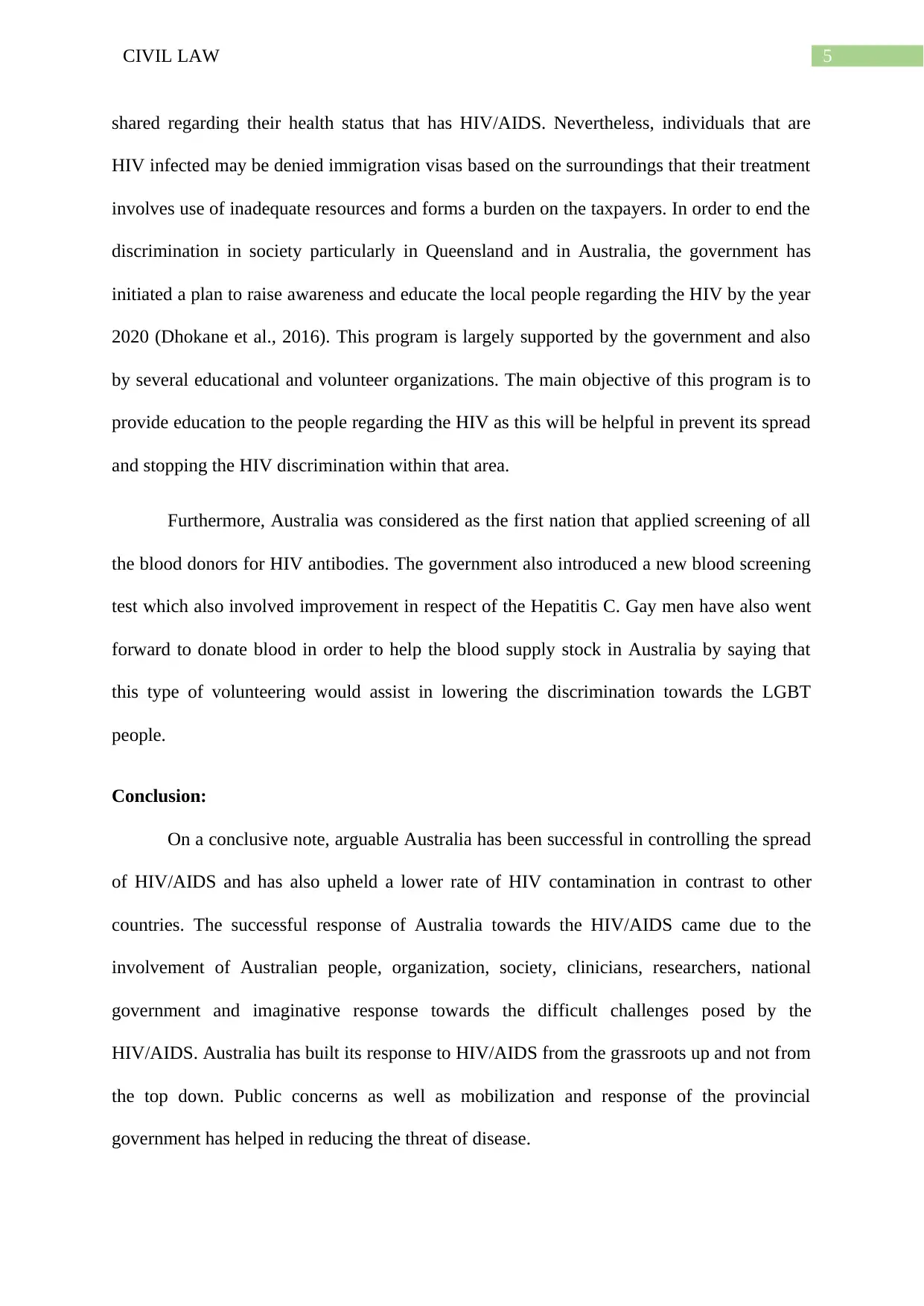
5CIVIL LAW
shared regarding their health status that has HIV/AIDS. Nevertheless, individuals that are
HIV infected may be denied immigration visas based on the surroundings that their treatment
involves use of inadequate resources and forms a burden on the taxpayers. In order to end the
discrimination in society particularly in Queensland and in Australia, the government has
initiated a plan to raise awareness and educate the local people regarding the HIV by the year
2020 (Dhokane et al., 2016). This program is largely supported by the government and also
by several educational and volunteer organizations. The main objective of this program is to
provide education to the people regarding the HIV as this will be helpful in prevent its spread
and stopping the HIV discrimination within that area.
Furthermore, Australia was considered as the first nation that applied screening of all
the blood donors for HIV antibodies. The government also introduced a new blood screening
test which also involved improvement in respect of the Hepatitis C. Gay men have also went
forward to donate blood in order to help the blood supply stock in Australia by saying that
this type of volunteering would assist in lowering the discrimination towards the LGBT
people.
Conclusion:
On a conclusive note, arguable Australia has been successful in controlling the spread
of HIV/AIDS and has also upheld a lower rate of HIV contamination in contrast to other
countries. The successful response of Australia towards the HIV/AIDS came due to the
involvement of Australian people, organization, society, clinicians, researchers, national
government and imaginative response towards the difficult challenges posed by the
HIV/AIDS. Australia has built its response to HIV/AIDS from the grassroots up and not from
the top down. Public concerns as well as mobilization and response of the provincial
government has helped in reducing the threat of disease.
shared regarding their health status that has HIV/AIDS. Nevertheless, individuals that are
HIV infected may be denied immigration visas based on the surroundings that their treatment
involves use of inadequate resources and forms a burden on the taxpayers. In order to end the
discrimination in society particularly in Queensland and in Australia, the government has
initiated a plan to raise awareness and educate the local people regarding the HIV by the year
2020 (Dhokane et al., 2016). This program is largely supported by the government and also
by several educational and volunteer organizations. The main objective of this program is to
provide education to the people regarding the HIV as this will be helpful in prevent its spread
and stopping the HIV discrimination within that area.
Furthermore, Australia was considered as the first nation that applied screening of all
the blood donors for HIV antibodies. The government also introduced a new blood screening
test which also involved improvement in respect of the Hepatitis C. Gay men have also went
forward to donate blood in order to help the blood supply stock in Australia by saying that
this type of volunteering would assist in lowering the discrimination towards the LGBT
people.
Conclusion:
On a conclusive note, arguable Australia has been successful in controlling the spread
of HIV/AIDS and has also upheld a lower rate of HIV contamination in contrast to other
countries. The successful response of Australia towards the HIV/AIDS came due to the
involvement of Australian people, organization, society, clinicians, researchers, national
government and imaginative response towards the difficult challenges posed by the
HIV/AIDS. Australia has built its response to HIV/AIDS from the grassroots up and not from
the top down. Public concerns as well as mobilization and response of the provincial
government has helped in reducing the threat of disease.

6CIVIL LAW
Paraphrase This Document
Need a fresh take? Get an instant paraphrase of this document with our AI Paraphraser
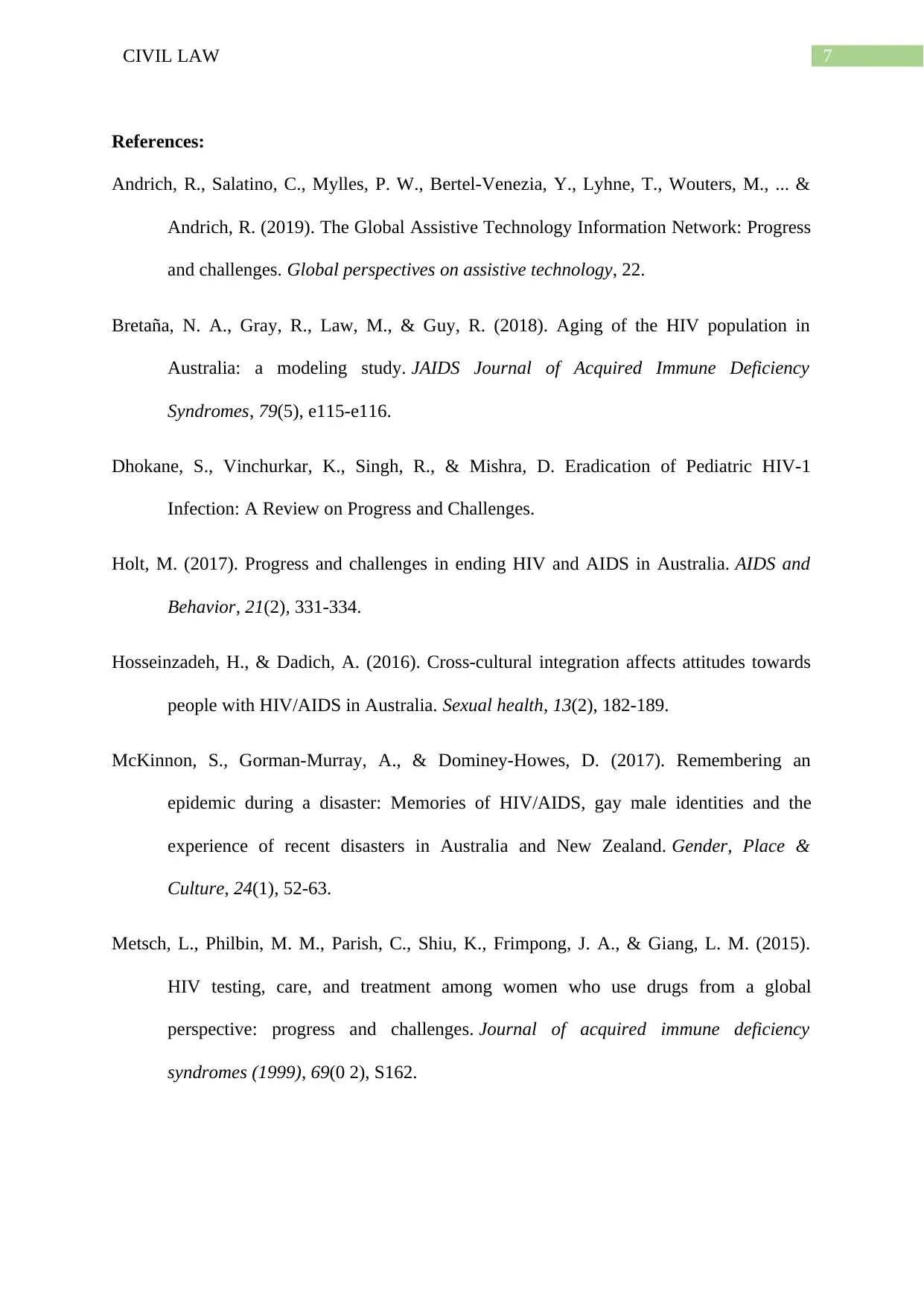
7CIVIL LAW
References:
Andrich, R., Salatino, C., Mylles, P. W., Bertel-Venezia, Y., Lyhne, T., Wouters, M., ... &
Andrich, R. (2019). The Global Assistive Technology Information Network: Progress
and challenges. Global perspectives on assistive technology, 22.
Bretaña, N. A., Gray, R., Law, M., & Guy, R. (2018). Aging of the HIV population in
Australia: a modeling study. JAIDS Journal of Acquired Immune Deficiency
Syndromes, 79(5), e115-e116.
Dhokane, S., Vinchurkar, K., Singh, R., & Mishra, D. Eradication of Pediatric HIV-1
Infection: A Review on Progress and Challenges.
Holt, M. (2017). Progress and challenges in ending HIV and AIDS in Australia. AIDS and
Behavior, 21(2), 331-334.
Hosseinzadeh, H., & Dadich, A. (2016). Cross-cultural integration affects attitudes towards
people with HIV/AIDS in Australia. Sexual health, 13(2), 182-189.
McKinnon, S., Gorman-Murray, A., & Dominey-Howes, D. (2017). Remembering an
epidemic during a disaster: Memories of HIV/AIDS, gay male identities and the
experience of recent disasters in Australia and New Zealand. Gender, Place &
Culture, 24(1), 52-63.
Metsch, L., Philbin, M. M., Parish, C., Shiu, K., Frimpong, J. A., & Giang, L. M. (2015).
HIV testing, care, and treatment among women who use drugs from a global
perspective: progress and challenges. Journal of acquired immune deficiency
syndromes (1999), 69(0 2), S162.
References:
Andrich, R., Salatino, C., Mylles, P. W., Bertel-Venezia, Y., Lyhne, T., Wouters, M., ... &
Andrich, R. (2019). The Global Assistive Technology Information Network: Progress
and challenges. Global perspectives on assistive technology, 22.
Bretaña, N. A., Gray, R., Law, M., & Guy, R. (2018). Aging of the HIV population in
Australia: a modeling study. JAIDS Journal of Acquired Immune Deficiency
Syndromes, 79(5), e115-e116.
Dhokane, S., Vinchurkar, K., Singh, R., & Mishra, D. Eradication of Pediatric HIV-1
Infection: A Review on Progress and Challenges.
Holt, M. (2017). Progress and challenges in ending HIV and AIDS in Australia. AIDS and
Behavior, 21(2), 331-334.
Hosseinzadeh, H., & Dadich, A. (2016). Cross-cultural integration affects attitudes towards
people with HIV/AIDS in Australia. Sexual health, 13(2), 182-189.
McKinnon, S., Gorman-Murray, A., & Dominey-Howes, D. (2017). Remembering an
epidemic during a disaster: Memories of HIV/AIDS, gay male identities and the
experience of recent disasters in Australia and New Zealand. Gender, Place &
Culture, 24(1), 52-63.
Metsch, L., Philbin, M. M., Parish, C., Shiu, K., Frimpong, J. A., & Giang, L. M. (2015).
HIV testing, care, and treatment among women who use drugs from a global
perspective: progress and challenges. Journal of acquired immune deficiency
syndromes (1999), 69(0 2), S162.
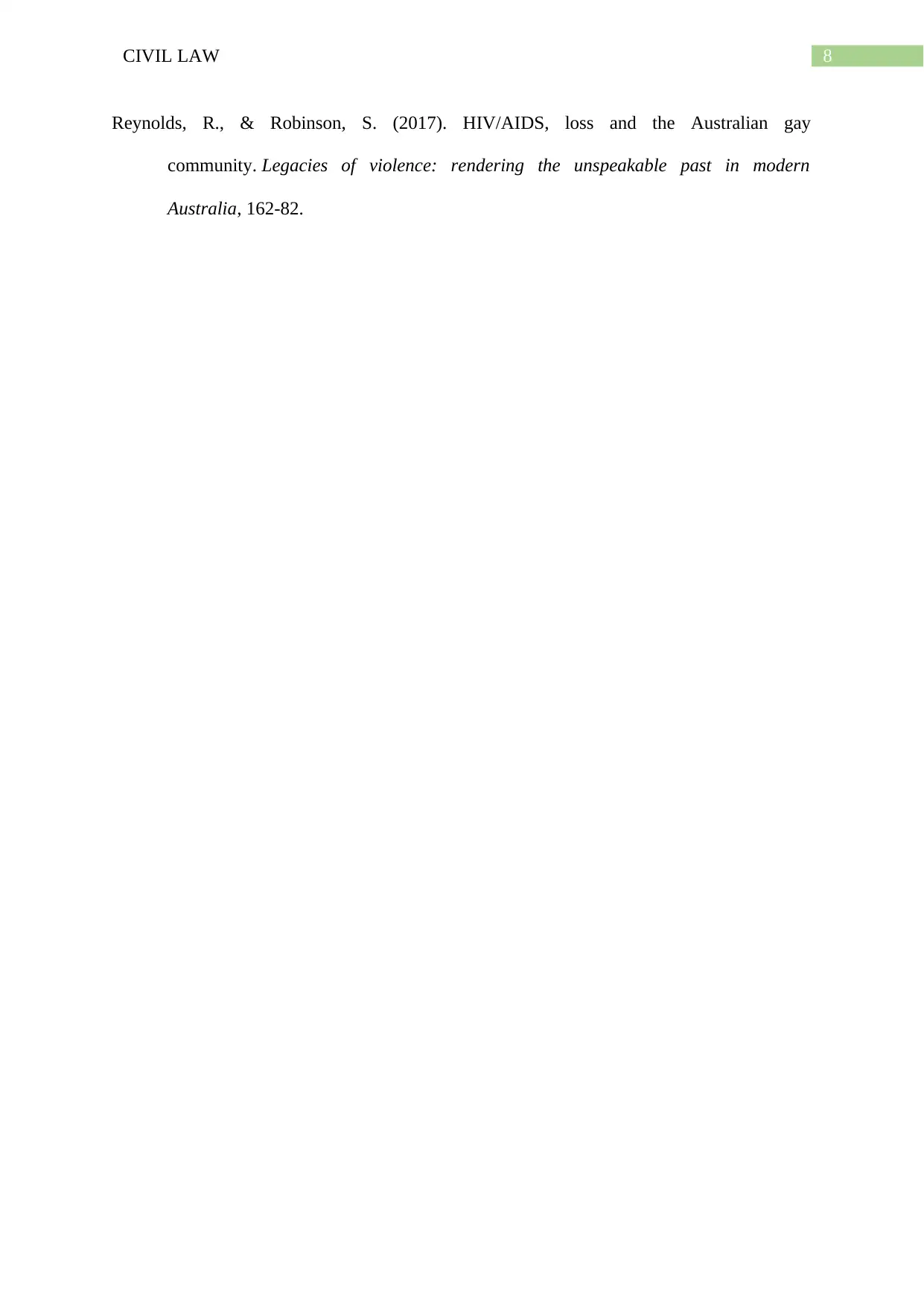
8CIVIL LAW
Reynolds, R., & Robinson, S. (2017). HIV/AIDS, loss and the Australian gay
community. Legacies of violence: rendering the unspeakable past in modern
Australia, 162-82.
Reynolds, R., & Robinson, S. (2017). HIV/AIDS, loss and the Australian gay
community. Legacies of violence: rendering the unspeakable past in modern
Australia, 162-82.
1 out of 9
Related Documents
Your All-in-One AI-Powered Toolkit for Academic Success.
+13062052269
info@desklib.com
Available 24*7 on WhatsApp / Email
![[object Object]](/_next/static/media/star-bottom.7253800d.svg)
Unlock your academic potential
© 2024 | Zucol Services PVT LTD | All rights reserved.





